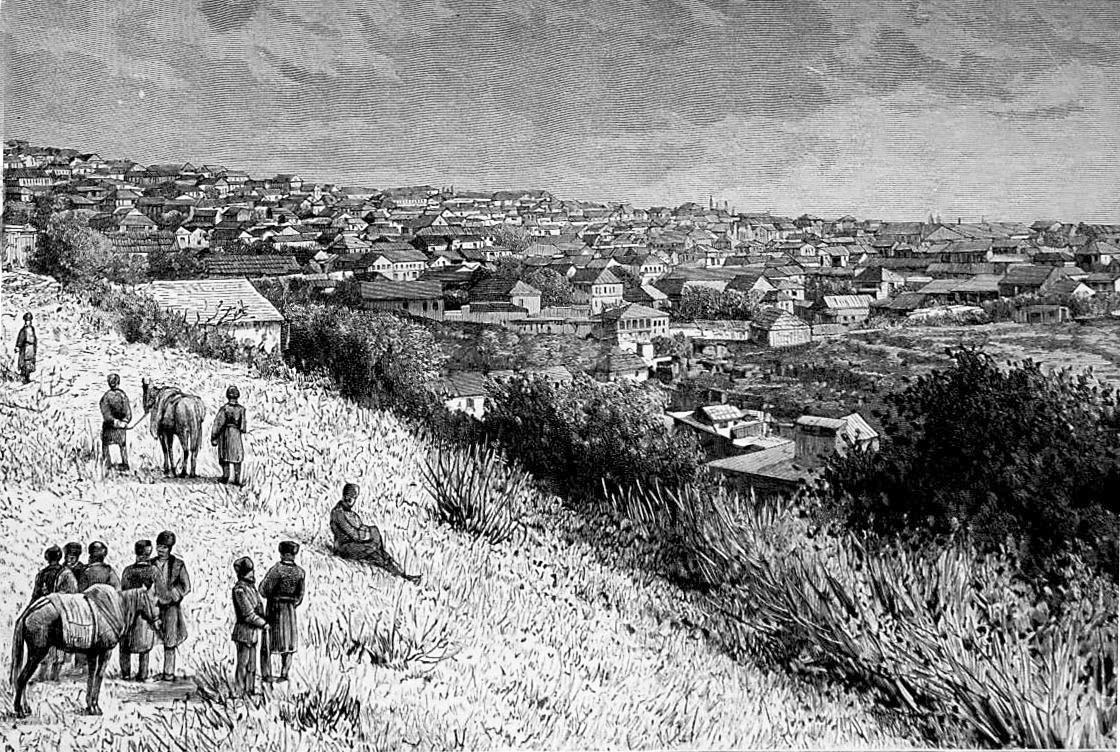In 1897, the Russian writer Vasily Sidorov published memoirs of his journey to the Caucasus. The book gives interesting facts about the Azerbaijani city of Shusha. Qarabag.com has prepared material about Sidorov’s description of beauty of the city and life of the people in Shusha.
Being in Nukha (now the Azerbaijani city of Sheki), many of the local population urged Sidorov not to go to Shusha because of the danger on the roads leading to this city. According to Sidorov, he was dissuaded from going to Shusha, as robberies on the way to the city occurred more and more often. The most famous robbers but at the same time folk heroes in Karabakh were Gachaq Nabi and Gachaq Ali. Translated from Azerbaijani, the word “gachaq” means a fugitive. They fought against those in power and helped the poor folk. In those days, people traveled to Shusha in groups, since single crews were more often robbed than joint groups. When Sidorov was leaving Sheki, the Molokan advised him not to resist the robbers if they attacked him and immediately give them “everything he has.” But despite all the dangers, Sidorov was unshakeable in his intention to see Shusha. The author points out in his arguments that it was the stories about the beauty of this city that made him, despite all the dangers, go and see Shusha with his own eyes.
[V. Sidorov. Across Russia. 2. Caucasus. Travel notes and impressions. Practical information for a tourist.1897, pp. 231-232]
On the way to Shusha, one of his companions, an Armenian, shared with him information about the history of Karabakh:
“Previously, this khanate was called Karabakh, and Shusha was called Panakh-abaz (more precisely, Panakh-abad). It’s just not clear how the Persians took this impregnable city.”
[V. Sidorov. Across Russia. 2. Caucasus. Travel notes and impressions. Practical information for a tourist.1897, pp. 235-236]
Sidorov, passing through the city of Aghdam, describes it as follows:
“After passing through earthy and very dangerous gorges, where a few days ago travelers were killed by robbers, we entered the large village of Aghdam, with its noisy bazaar and huge mulberry gardens, completely covered with vines.”
[V. Sidorov. Across Russia. 2. Caucasus. Travel notes and impressions. Practical information for a tourist.1897, pp. 238]
Gradually approaching by stagecoach to Shusha V.Sidorov wrote: “The mountains around rose up like walls, some looked as if they had been cut off with a knife, others took the form of fantastic castles, and in the distance on the highest mountain the fortresses of Shusha were vaguely outlined.
– Are we really going up there? I exclaimed, looking into this beyond the clouds height.
-Yes, the neighbor replied, Shusha is there, and now the famous ascent to the mountains will begin.
After the last Khojaly station, we really began to climb noticeably and all 231\4 versts to Shusha crawled uphill along such an amazing and puzzling road that the memory of it makes me feel giddy… On one side of the Askeran valley, there were Katuk and Ternavaz mountains. At the noisy stream along which the road wound, we met either the large caravanserais of Suleiman Khan with an arch of gates in the shade of old elms, or the remains and ruins surrounded by pyramidal poplars with black holes instead of windows, some white buildings of the former khanate… In one place, the fellow travelers pointed out a beautiful waterfall of the Dashalty river, which broke off from the rocks and fell into a deep black valley. We were surrounded by gloomy and desolate rocks consisting of small folds. We climbed higher and higher, and wonderful views opened up with every step in all directions.”
[V. Sidorov. Across Russia. 2. Caucasus. Travel notes and impressions. Practical information for a tourist.1897, pp. 239-240]
The author mentions the following settlements that he met on his way to Shusha: Khan-Tiendy (Khankendi), Dashkent and Shushu-kent (Shushakent). Then, having reached Shusha, Sidorov writes about his first impressions of it:
“We are all crawling uphill and there is still no end to the road. How many times it seemed that we were about to go around the mountain and reach the city, and Shusha was still visible far away at some unattainable height. Finally, a chaotic suburban cemetery in a wild and desolate area appeared. What a picturesque pile of Tatar monuments, as if someone dropped them from the sky and they all lay down at random. Ahead, fortress walls appeared on the tops of the mountains, then running down into the depths of the precipices and then climbing to the peaks. We entered the city gates already in the darkness of the night and walked along the terrifying roadway. Never in my life have I experienced such tremors, neither in the Kurmuk which is full of stones, nor in the Ural streams, nor in the Siberian bumpy roads. As if the stones of the most unsuitable size were deliberately picked up and someone paved the streets with them. The potholes of some piles of stones in these narrow, dark and smelly streets of Shusha made me feel really bad. We were dropped off in a dark, completely unlit square.”
[V. Sidorov. Across Russia. 2. Caucasus. Travel notes and impressions. Practical information for a tourist.1897, pp. 240-241]

Being in Shusha V.Sidorov compares the Azerbaijani and Armenian quarters of Shusha. He also indicates that the population of Shusha – 26.086 inhabitants.
“I went to wander around the city which is lying on the mountains, at an altitude of 5,076 feet. I made my way through its dark alleys, along its incredibly vile pavements, on which citizens do not risk walking in the evening and prefer to stay at home in the poor lighting of the city. The Armenian part of the city, with its uninteresting monasteries, theological seminary, small white houses, narrow streets and alleys, is of little interest. If anything deserves some attention, it is the new cathedral and views. The views of the surroundings, the precipices, the streams falling into hollows and precipices, the road winding along the rocks beyond Shusha in Ghiryuzi (probably the city of Goris, now Armenia) and Jabrail are really charming. The Tatar part of the city is much more picturesque, although its pavement is even more terrible, and the stench and dirt on the streets are more striking. Tatar Maidan is even more lively and it is decorated with a charming mottled mosque with two slender and unusually elegant minarets, from behind which a large mottled tiled dome with a crescent moon on top can be seen. At this mosque, fanatical Tatars and Persians celebrate the memory of Huseyn and Ali. There is a wild procession of self-torturers who, in the heat of religious ecstasy, beat themselves with knives and swords, tear their bodies while singing religious hymns and pour blood over the stones of the square, which flows in streams from their wounds. There is also the khan’s palace with its garden and balconies, little interesting in appearance, now belonging to the daughter of the former sovereign khan.”
[V. Sidorov. Across Russia. 2. Caucasus. Travel notes and impressions. Practical information for a tourist.1897, pp. 240-241; 651]
Leaving Shusha, V. Sidorov finally met with a local archaeologist, teacher Ressler, a German by origin, who showed him a lot of ancient arrows, bronze products, jewelry, urns and vases and other objects found from the excavations of burial mounds in the vicinity of Shusha and Zangezur uyezd.
[V. Sidorov. Across Russia. 2. Caucasus. Travel notes and impressions. Practical information for a tourist.1897, pp. 245]




